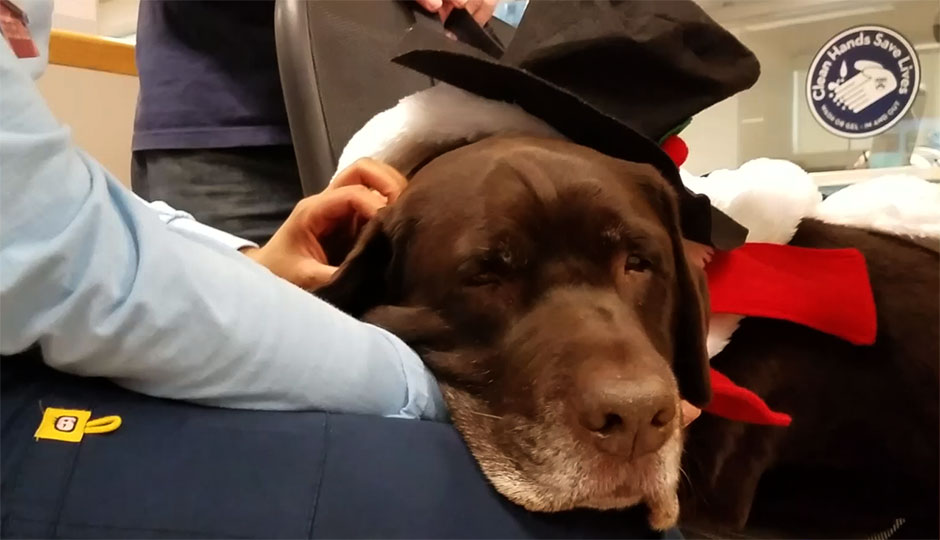How HUP’s Pups Help Hospital Patients, Caregivers

Image courtesy Penn Medicine
It’s not fun to be in the hospital on a holiday. But there are some four-legged friends who are helping to boost everyone’s mood this Christmas.
In truth, the therapy dogs at the Hospital of the University of Pennsylvania work year-round, but Tugger (the dog in the image above) dressed up as a snowman for the winter holiday season earlier this month. So cute!
The Penn therapy dog program, HUP’s Pups, started seven years ago. Juliane Jablonski, a clinical nurse specialist who has worked at the hospital for a decade, saw the success that many pediatric hospitals had bringing in therapy dogs for their patients. The Gerald B. Shreiber Pet Therapy Program at the Children’s Hospital of Philadelphia is popular; why couldn’t its neighbor do something for the adult population?
Jablonski, who lives in Manayunk, made sure it happened (with the help of HUP director of volunteer services Donna Griffith). Therapy dogs began making the rounds at HUP and have been hugely popular with patients. “The animals are like celebrities,” Jablonski says. “And the minute they walk onto a unit everyone stops in their place. It just brings immediate smiles. And it’s amazing — I have rarely seen this effect from anything else.”
Most studies show animal-assisted therapy, as it is professionally called, does produce positive outcomes for patients. Research at Penn itself dates back at least 40 years: In 1977, Penn psychiatrist Dean Katcher and assistant Erika Friedmann performed a study that found people who interacted with pets had lower blood pressure than people who interacted with family members. Though there are design issues with many studies supporting animal-assisted therapy, most of the evidence points to positive outcomes.
At Penn, Jablonski says, it hasn’t just been good for the patients. “Yes, it’s obvious that we started this program for the patients,” she says. “But it has also turned into an incredible boost for staff morale. It’s just been a great stress reliever for our own caregivers for years.” She says many of the patients have grown attached to the animals. Nine-year-old Tugger, who dressed up as Frosty, has been with the program since its inception.
So far, the only therapy animals Penn uses are dogs. A caregiver asks before a dog is taken into a patient’s room, in case the patient is allergic to or afraid of dogs. But most of the time, Jablonski says, no one even has to ask. “What generally happens is: Once the animal comes to the floor, family members will come out and say, ‘Oh, please, come see my mom here.’ It really does organically sort of feed off itself. We don’t even really have to ask people — they come asking for the dog.”
The success of HUP’s Pups goes beyond whatever benefits the companionship of a dog bring. Jablonski says the dogs also allow caregivers and patients to bond over a common interest, allowing better communication between the two sides. “We’ve had physicians and patients who had their usual relationship as far doctor and patient,” she says. “And then once the dog came into the picture, they connected. They were able to start talking about dogs and it just put a whole new engagement between them. I think it’s incredible of how these animals can become such a starting point for connecting people because it lowers everyone’s inhibitions and relaxes everyone.”
Follow @dhm on Twitter.